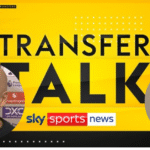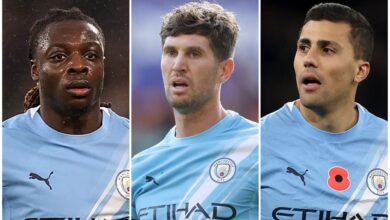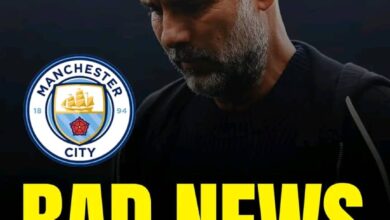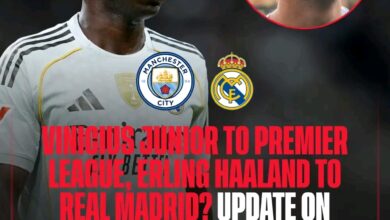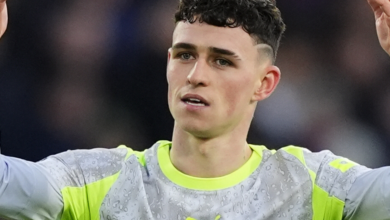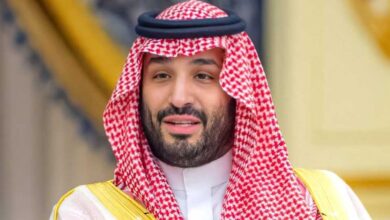City Confirm Signing of PSG Forward Following Medical and Contract Agreement

In the ever-evolving landscape of modern football, where astronomical transfer fees dominate headlines and established stars command the spotlight, Manchester City have once again demonstrated their mastery of strategic recruitment with a move that exemplifies their long-term vision. The signing of Mahamadou Sangaré, an 18-year-old striker from Paris Saint-Germain’s youth academy, represents far more than a simple transfer—it’s a statement of intent that underscores the Citizens’ commitment to nurturing tomorrow’s superstars while their rivals chase today’s established names.
The confirmation of Sangaré’s arrival at the Etihad Stadium, following a successful medical examination and the agreement of personal terms on a five-year contract, marks another chapter in Manchester City’s relentless pursuit of global excellence. This acquisition, set to be officially completed on July 1st, 2025, represents the kind of calculated risk-taking that has transformed City from Premier League challengers into a global powerhouse capable of attracting the brightest young talents from across the footballing world.
A Star Born in Mali: The Making of Mahamadou Sangaré
Born in the town of Dionkoulané in Mali, Mahamadou Sangaré’s journey to Manchester represents the globalization of modern football at its finest. His story is one of rapid ascension through the ranks of youth football, culminating in what many consider to be one of the most impressive individual campaigns in recent UEFA Youth League history. The young striker’s trajectory from the dusty pitches of West Africa to the pristine training facilities of Paris Saint-Germain, and now to the state-of-the-art City Football Academy, illustrates the increasingly international nature of talent identification and development in contemporary football.
Sangaré’s rise has been nothing short of meteoric. Despite never featuring for PSG’s senior squad, his performances at youth level have been so compelling that they’ve caught the attention of one of Europe’s most sophisticated scouting networks. His ability to adapt to different playing styles and tactical systems, combined with his natural athleticism and technical proficiency, marks him out as a player with the potential to thrive in the demanding environment of English football.
The young Malian’s multicultural background—born in Mali but developed through the French youth system—provides him with a unique perspective that could prove invaluable as he adapts to life in Manchester. His experience of navigating different cultures and football philosophies has likely contributed to the mental resilience and adaptability that top-level football demands.
Youth League Excellence: Breaking Down the Numbers
Sangaré’s standout season in the UEFA Youth League serves as the foundation for City’s interest and provides concrete evidence of his potential at the highest levels of youth football. Finishing as joint top scorer with eight goals, level with Matviy Ponomarenko of Dynamo Kyiv and Phillip Verhounig of RB Leipzig, the young striker demonstrated his ability to perform when it matters most against Europe’s finest young talents.
These eight goals weren’t merely a product of individual brilliance—they represented a comprehensive understanding of positioning, timing, and clinical finishing that sets elite strikers apart from their peers. Each goal told a story of tactical intelligence, whether it was his ability to find space in crowded penalty areas, his timing of runs to beat defensive lines, or his composure in high-pressure moments that separate promising youngsters from future professionals.
The Youth League, often serving as a proving ground for players destined for senior football, has historically been an excellent predictor of future success. Previous top scorers and standout performers in the competition have gone on to establish themselves at the highest levels of European football, suggesting that Sangaré’s achievements represent far more than mere youth-level success.
His goal tally becomes even more impressive when considered within the context of PSG’s tactical approach and the quality of opposition faced. Competing against established youth academies from across Europe, including those of Barcelona, Real Madrid, Manchester City, and other continental giants, Sangaré consistently found ways to impact games and deliver when his team needed him most.
International Recognition: France’s Faith in Youth
The call-up to France’s U18 squad for friendlies against Tunisia and the Netherlands in November 2024 represents another significant milestone in Sangaré’s development. Despite his Malian birth, his selection for Les Bleus at youth level indicates the high regard in which French football authorities hold his potential.
This international recognition carries particular weight given France’s incredible depth in attacking positions and their historically rigorous selection processes at all levels. The French national team setup, renowned for its meticulous approach to player development and its track record of producing world-class talent, doesn’t hand out caps lightly—even at youth level.
The timing of his international debut, coming during his breakthrough season with PSG’s youth teams, suggests that his performances hadn’t gone unnoticed by the broader French football establishment. This external validation from national team coaches, who have access to the entire pool of French youth talent, provides additional evidence of Sangaré’s exceptional potential.
The experience of representing France, even at youth level, will have exposed Sangaré to different tactical approaches, higher levels of intensity, and the pressure that comes with international football. These experiences, though brief, contribute to the mental development that will prove crucial as he transitions to senior football in England.
Tactical Profile: Dissecting the Modern Forward
To understand why Manchester City moved decisively for Sangaré, it’s essential to analyze his tactical profile and how it aligns with the demands of modern football. According to Mohamed Sissoko, the former PSG and Liverpool midfielder who serves as Sangaré’s advisor, the young striker embodies the versatility that contemporary football demands.
“I see him as a true number 9, but it’s true that he’s also pretty good on the wings,” Sissoko explained, highlighting the positional flexibility that has become increasingly valuable in today’s tactical landscape. This adaptability allows coaches to deploy him in various formations and systems, whether as a traditional center-forward in a 4-4-2 formation or as part of a front three in a 4-3-3 setup.
This versatility addresses one of the key challenges facing modern forwards: the need to contribute across multiple positions and phases of play. Gone are the days when strikers could simply focus on scoring goals; today’s elite forwards must press effectively, link play, create space for teammates, and contribute defensively when required.
PSG youth coach David Suarez provided additional insight into Sangaré’s tactical preferences and strongest attributes. “He has a preferred zone, which is on the right side of the pitch, to finish with his left foot,” Suarez noted, identifying a specific strength that could prove particularly valuable in Pep Guardiola’s system, which often utilizes inverted wingers cutting inside onto their stronger foot.
Suarez continued, “He moves to finish with wraparounds and inside shots, like the goals he scored in the Youth League. He has this ability to finish, to be in the box, and even within 5.50m on crosses.” This description paints a picture of a player with exceptional spatial awareness and the ability to find scoring positions in tight areas—skills that are particularly valuable in the Premier League, where defensive organization and compactness often limit scoring opportunities.
Physical Attributes: Speed Meets Technique
One of Sangaré’s most remarkable attributes is his pace, with coach Suarez noting that “He is capable of going up to 35-36 km/h.” This exceptional speed, approaching the levels of elite sprinters, provides him with a significant advantage in modern football, where the ability to exploit space behind defensive lines can be decisive.
However, raw pace without control and intelligence often proves ineffective at the highest levels. Suarez emphasized the importance of Sangaré’s ability to “change pace,” describing it as “a slider that he must go for.” This acceleration and deceleration ability—the capacity to vary his running rhythm to unsettle defenders—represents a more sophisticated use of his physical gifts.
The combination of straight-line speed and the ability to change direction and pace makes Sangaré a nightmare for defenders to handle. In one-on-one situations, defenders must respect his pace, but his ability to slow down, change direction, or burst away at unexpected moments adds layers of complexity to defending against him.
This physical profile aligns perfectly with the demands of Premier League football, where the pace of play and physicality of defending require forwards to be both explosive and resilient. The English top flight has historically favored players who can combine technical ability with physical attributes, and Sangaré appears to possess both in abundance.
The Guardiola Factor: Perfect Fit for City’s System
Pep Guardiola’s tactical philosophy and his track record of developing young forwards make Manchester City an ideal destination for Sangaré’s continued development. The Catalan coach’s system demands intelligence, adaptability, and discipline—qualities that the young striker has already demonstrated at youth level.
Guardiola’s approach to forward play has evolved significantly during his time at City, with the coach showing increasing willingness to utilize pace and directness as weapons within his possession-based system. Players like Gabriel Jesus, Riyad Mahrez, and Julian Álvarez have all thrived under Guardiola’s guidance, suggesting that Sangaré’s profile could fit seamlessly into the coach’s tactical framework.
The emphasis on positional play and tactical flexibility in Guardiola’s system should suit Sangaré’s versatility, allowing him to develop understanding of multiple positions and roles within the team structure. This exposure to different tactical responsibilities will accelerate his development and increase his value as a squad player.
Furthermore, Guardiola’s history of integrating young players into his squads, from Phil Foden to Cole Palmer (before his departure), demonstrates his willingness to trust youth when players demonstrate the required application and ability. Sangaré’s professional attitude and hunger for improvement, evident in his rapid rise through PSG’s youth ranks, suggest he possesses the mentality to thrive under Guardiola’s demanding standards.
Strategic Implications: City’s Long-Term Vision
The signing of Sangaré represents much more than the acquisition of a promising young player—it exemplifies Manchester City’s strategic approach to squad building and their position within the global football ecosystem. By securing the striker’s signature ahead of other interested parties, City have demonstrated their ability to compete not just for established stars but for the next generation of elite talent.
This transfer reflects several key aspects of City’s recruitment philosophy. First, their willingness to invest in potential rather than proven ability, understanding that the greatest returns often come from players acquired before their market value peaks. Second, their global scouting network’s effectiveness in identifying talent across different markets and competition levels.
The timing of the transfer also speaks to City’s planning capabilities. By securing Sangaré’s signature during the summer of 2025, they’ve addressed a potential future need while allowing themselves time to properly integrate the player into their system. This forward-thinking approach prevents the panic buying that often characterizes clubs operating with shorter-term perspectives.
From a financial perspective, acquiring Sangaré as a free agent represents exceptional value in today’s inflated transfer market. While his wages and associated costs will still represent a significant investment, the absence of a transfer fee allows City to allocate resources more efficiently across their squad development.
Development Pathway: The Road Ahead
Sangaré’s immediate future likely lies within Manchester City’s academy system or through carefully planned loan arrangements designed to accelerate his development. The City Football Group’s network of clubs provides numerous opportunities for the young striker to gain valuable experience at appropriate levels.
The success of City’s development pathway is evident in players like Phil Foden, who progressed from the academy to become a key first-team player, and others who have used the City system as a springboard to successful careers elsewhere. This track record should provide Sangaré with confidence that his development will be carefully managed and optimized.
The key to Sangaré’s progression will be finding the right balance between challenge and support. Too much pressure too early could stunt his development, while insufficient challenge might prevent him from reaching his potential. City’s experience in managing young talent suggests they understand this delicate balance.
Regular involvement with City’s first-team training sessions, even without immediate matchday selection, will expose Sangaré to the intensity and standards required at the highest level. This exposure, combined with competitive minutes at an appropriate level, should accelerate his adaptation to English football.
Global Impact: Beyond the Pitch
Sangaré’s signing also carries significance beyond its immediate footballing implications. As a player born in Mali but developed through the French system and now joining an English club, he represents the increasingly international nature of modern football.
His success could inspire other young African players to pursue similar paths, potentially strengthening the pipelines between African talent and European clubs. This could have positive implications for football development across Africa, as successful role models often motivate increased participation and investment in youth development.
The signing also reinforces Manchester City’s reputation as a destination willing to invest in young talent from diverse backgrounds. This reputation could prove valuable in future recruitment efforts, particularly in emerging markets where relationships and trust play crucial roles in transfer negotiations.
Market Analysis: Value in an Inflated Landscape
In a transfer market where young talents increasingly command enormous fees, Sangaré’s acquisition as a free agent represents shrewd business. Players with similar profiles and potential have commanded transfer fees in excess of €20-30 million in recent windows, making this deal exceptional value for City.
The financial efficiency of this transfer allows City to invest more heavily in other areas of their squad while still securing a potentially valuable asset. If Sangaré develops as expected, his market value could increase dramatically over the course of his five-year contract.
This approach also demonstrates City’s confidence in their development systems and coaching capabilities. By investing in raw potential rather than proven ability, they’re backing their ability to add value through coaching and development—a strategy that has proven successful throughout their recent history.
Fan Expectations: Managing Hope and Reality
Manchester City supporters, accustomed to immediate success and star signings, will need to adjust their expectations for Sangaré’s impact timeline. This transfer represents a different type of investment—one focused on future returns rather than immediate contributions.
The excitement surrounding his UEFA Youth League performances should be tempered with realistic expectations about the challenges of transitioning to senior football. Many promising youth players struggle with this step up, regardless of their potential or previous achievements.
However, City’s track record with young player development should provide supporters with confidence that Sangaré will be given every opportunity to succeed. The club’s patient approach to player development, evidenced by their handling of talents like Foden and others, suggests they understand the importance of proper progression.
Conclusion: A Transfer for the Future
The signing of Mahamadou Sangaré represents Manchester City at their strategic best—identifying talent before it becomes expensive, securing promising players ahead of competitors, and investing in the future while maintaining present success. While immediate first-team impact seems unlikely, the long-term potential of this acquisition could prove transformative.
Sangaré’s combination of pace, technical ability, tactical versatility, and proven goal-scoring instinct at youth level provides City with a player who could develop into exactly the type of forward modern football demands. His journey from Mali to Manchester, via Paris, illustrates both his personal determination and City’s global reach in talent identification.
As the young striker prepares to begin his City career, he carries with him the hopes of becoming the latest success story in the club’s impressive academy system. While the challenges ahead are significant, his potential rewards—both for player and club—could be extraordinary. In an era where football success increasingly depends on identifying and developing talent before competitors, Manchester City’s acquisition of Mahamadou Sangaré may well be remembered as another masterstroke in their continuing evolution as a global football powerhouse.
The next chapter of Sangaré’s career begins in Manchester, where dreams are built on the foundation of hard work, tactical intelligence, and unwavering commitment to excellence. Time will tell whether this promising young striker can fulfill his potential and justify City’s faith in his abilities, but all the ingredients appear to be in place for another remarkable development success story at the Etihad Stadium.


